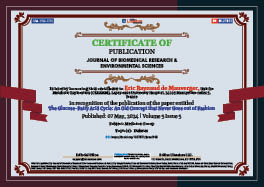Medicine Group. 2024 May 07;5(5):415-416. doi: 10.37871/jbres1908.
The Glucose-Fatty Acid Cycle: An Old Concept that Never Goes out of Fashion
Eric Raynaud de Mauverger*
Introduction
Sir Philip Randle and his colleagues [1] proposed in 1963 the concept of a glucose-fatty acid cycle as an integrated approach of mechanisms by which carbohydrate and fat metabolisms interact. There were two major aspects in their historical contribution: a physiological one, with the ability of oxidative muscles to alternate between the use of glucose and lipids to produce ATP, according to their relative availabilities; a pathophysiological one, with the underlying idea that substrate competition could be an important determinant for the development of insulin resistance. While the general principle of the cycle has been confirmed by many authors, lots of new mechanisms controlling glucose and fatty acids interaction have been proposed, and the “so-called” Randle cycle is still a matter of debate. Very few concepts in the field of metabolism have the good fortune to be challenged fifty years after their proposition. Three contributions illustrate this incredible modernity. Marcelino and colleagues [2], in an elegant study of deleterious metabolic effects of catch-up growth, depict competition between glucose and lipids for fat storage as triglycerides in white adipocytes as an extension of the Randle cycle. During catch-up fat under high-fat diet, this direct competition, via inhibition of de novo lipogenesis, would lead to diminish glucose utilisation in adipocytes and hepatocytes and thus promote glucose intolerance. Another report focuses on the Randle hypothesis in skeletal muscle, one aspect of the glucose-fatty acid cycle still debated today. Keung and colleagues [3] demonstrate how inhibition of carnitine palmitoyltransferase-1, which allows entrance of fatty acids in mitochondria, by oxfenicine, leads to increased carbohydrate utilisation, facilitated by an increased activity of the pyruvate dehydrogenase complex. These results are highly suggestive of an operating Randle cycle in skeletal muscle. Last but not least, an outstanding review [4] replaces the Randle cycle together with mitochondrial dysfunction, insulin resistance and oxidative stress in a large pathophysiological view of non-alcoholic fatty liver disease.
May be is it time to listen to Professor Philip Randle [1]. “Perhaps this paper [1] has been cited frequently, because it summarised, at an opportune moment, a phase in the development of understanding of the process of fuel selection in mammalian muscle.” At an opportune moment, indeed? Sixty years later, still on stage: many thanks, Sir.
Conflicts of Interest
I declare that I have no conflicts of interest.
References
- Randle PJ, Garland PB, Hales CN, Newsholme EA. The glucose fatty-acid cycle. Its role in insulin sensitivity and the metabolic disturbances of diabetes mellitus. Lancet. 1963 Apr 13;1(7285):785-9. doi: 10.1016/s0140-6736(63)91500-9. PMID: 13990765.
- Marcelino H, Veyrat-Durebex C, Summermatter S, Sarafian D, Miles-Chan J, Arsenijevic D, Zani F, Montani JP, Seydoux J, Solinas G, Rohner-Jeanrenaud F, Dulloo AG. A role for adipose tissue de novo lipogenesis in glucose homeostasis during catch-up growth: a Randle cycle favoring fat storage. Diabetes. 2013 Feb;62(2):362-72. doi: 10.2337/db12-0255. Epub 2012 Sep 6. PMID: 22961086; PMCID: PMC3554390.
- Keung W, Ussher JR, Jaswal JS, Raubenheimer M, Lam VH, Wagg CS, Lopaschuk GD. Inhibition of carnitine palmitoyltransferase-1 activity alleviates insulin resistance in diet-induced obese mice. Diabetes. 2013 Mar;62(3):711-20. doi: 10.2337/db12-0259. Epub 2012 Nov 8. PMID: 23139350; PMCID: PMC3581198.
- García-Ruiz C, Baulies A, Mari M, García-Rovés PM, Fernandez-Checa JC. Mitochondrial dysfunction in non-alcoholic fatty liver disease and insulin resistance: cause or consequence? Free Radic Res. 2013 Nov;47(11):854-68. doi: 10.3109/10715762.2013.830717. Epub 2013 Oct 4. PMID: 23915028.
Content Alerts
SignUp to our
Content alerts.
 This work is licensed under a Creative Commons Attribution 4.0 International License.
This work is licensed under a Creative Commons Attribution 4.0 International License.








